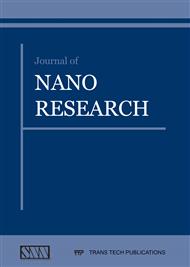[1]
Y.T. Zhang, S.J. Bai, W. Zhang, An improved method for determination of trace hydrogen peroxide in water, J. Environ. Health, 23 (2006) 258-261.
Google Scholar
[2]
M. Hoshino, S. Kamino, M. Doi, S. Takada, S. Mitani, R. Yanagihara, M. Asano, T. Yamaguchi, Y. Fujita, Spectrophotometric determination of hydrogen peroxide with osmium(VIII) and m-carboxyphenylfluorone, Spectrochim. Acta A, 117 (2014) 814-816.
DOI: 10.1016/j.saa.2013.08.048
Google Scholar
[3]
Q.Z. Zhai, X. X Zhang, R.B. Zhang, Spectrophotometric determination of hydrogen peroxide based on fading of tribromoarsenazo oxidation by hydrogen peroxide catalyzed by hemoglobin, Asian J. Chem., 25 (2013) 4099-4102.
DOI: 10.14233/ajchem.2013.14475c
Google Scholar
[4]
L.J. Zhang, Y.C. Chen, Z.M. Zhang, C. Lu, Highly selective sensing of hydrogen peroxide based on cobalt-ethylenediaminetetraacetate complex intercalated layered double hydroxide-enhanced luminal chemiluminescence, Sensor and Actuat B-Chem., 193 (2014).
DOI: 10.1016/j.snb.2013.12.036
Google Scholar
[5]
M. Xu, J.M. Han, Y.Q. Zhang, X.M. Yang, L. Zang, A selective fluorescence turn-on sensor for trace vapor detection of hydrogen peroxide, Chem. Commun., 49 (2013) 11779-11781.
DOI: 10.1039/c3cc47631f
Google Scholar
[6]
T. Wen, F. Qu, N.B. Li, H.Q. Luo, Polyethyleneimine-capped silver nanoclusters as a fluorescence probe for sensitive detection of hydrogen peroxide and glucose, Anal. Chim. Acta, 749 (2012) 56-62.
DOI: 10.1016/j.aca.2012.08.048
Google Scholar
[7]
J. Liu, S.M. Sreinberg, B.J. Johnson, A high performance liquid chromatography method for determination of gas-phase hydrogen peroxide in ambient air using Fenton's chemistry, Chemosphere, 52 (2003) 815-823.
DOI: 10.1016/s0045-6535(03)00260-1
Google Scholar
[8]
J.P. Wang, H. Gao, F.L. Sun, C.X. Xu, Nanoporous PtAu alloy as an electrochemical sensor for glucose and hydrogen peroxide, Sensor and Actuat B-Chem., 191 (2014) 612-618.
DOI: 10.1016/j.snb.2013.10.034
Google Scholar
[9]
Y.B. Zhou, G. Yu, F.F. Chang, B.N. Hu, C.J. Zhong, Gold-platinum alloy nanowires as highly sensitive materials for electrochemical detection of hydrogen peroxide, Anal. Chim. Acta, 757 (2012) 56-62.
DOI: 10.1016/j.aca.2012.10.036
Google Scholar
[10]
M. Shamsipur, A. Pashabadi, F. Molaabasi, A novel electrochemical hydrogen peroxide biosensor based on hemoglobin capped gold nanoclusters-chitosan composite, RSC Adv., 5 (2015) 61725-61734.
DOI: 10.1039/c5ra09216g
Google Scholar
[11]
Y. Wu, J. Huang, T. Zhou, M. Rong, Y. Jiang, X. Chen, A novel solid-state electrochemiluminescence sensor for the determination of hydrogen peroxide based on an Au nanocluster-silica nanopaticle nanocomposite, Analyst, 138 (2013) 5563-5565.
DOI: 10.1039/c3an01207g
Google Scholar
[12]
Z.G. Mao, Z.H. Qing, T.P. Qing, F.Z. Xu, L. Wen, X.X. He, D.G. He, H. Shi, K.M. Wang, Poly(thymine)-templated copper nanoparticles as a fluorescent indicator for hydrogen peroxide and oxidase-based biosensing, Anal. Chem., 87 (2015) 7454-7460.
DOI: 10.1021/acs.analchem.5b01700
Google Scholar
[13]
R. Lei, Z. Du, Y. Qiu, S. Zhu, The detection of hydrogen peroxide involved in plant virus infection by fluorescence spectroscopy, Luminescence, 31 (2016) 1158-1165.
DOI: 10.1002/bio.3090
Google Scholar
[14]
M. Lan, Y. Di, X. Zhu, T.W. Ng, J. Xia, W. Liu, X. Meng, P. Wang, C.S. Lee, W. Zhang, A carbon dot-based fluorescence turn-on sensor for hydrogen peroxide with a photo-induced electron transfer mechanism, Chem. Commun., 51 (2015) 15574-15577.
DOI: 10.1039/c5cc05835j
Google Scholar
[15]
F.C. Vicentini, L.L.C. Garcia, L.C.S. Figueiredo-Filho, B.C. Janegitz, O. Fatibello-Filho, A biosensor based on gold nanoparticles, dihexadecylphosphate, and tyrosinase for the determination of catechol in natural water, Enzyme Microb. Technol., 84 (2016).
DOI: 10.1016/j.enzmictec.2015.12.004
Google Scholar
[16]
X.C. Shen, L.F. Jiang, H. Liang, X. Lu, L.J. Zhang, X.Y. Liu, Determination of 6-mercaptopurine based on the fluorescence enhancement of Au nanoparticles, Talanta, 69 (2006) 456-462.
DOI: 10.1016/j.talanta.2005.10.017
Google Scholar
[17]
H.H. Deng, G.W. Wu, D. He, H.P. Peng, A.L. Liu, X.H. Xia, W. Chen, Fenton reaction-mediated fluorescence quenching of N-acetyl-L-cysteine-protected gold nanoclusters: analytical applications of hydrogen peroxide, glucose, and catalase detection, Analyst, 140 (2015).
DOI: 10.1039/c5an01284h
Google Scholar
[18]
P. Zhang, Y. Wang, Y. Yin, Facile fabrication of a gold nanocluster-based membrane for the detection of hydrogen peroxide, Sensors, 16 (2016) 1124.
DOI: 10.3390/s16071124
Google Scholar
[19]
H.C. Chang, J.A. Ho, Gold nanocluster-assisted fluorescent detection for hydrogen peroxide and cholesterol based on the inner filter effect of gold nanoparticles, Anal. Chem., 87 (2015) 10362-10367.
DOI: 10.1021/acs.analchem.5b02452
Google Scholar
[20]
Y.N. Hwang, D.H. Jeong, H.J. Shin, D. Kim, S.C. Jeoung, S.H. Han, J.S. Lee, G. Cho, Femtosecond emission studies on gold nanoparticles. J. Phys. Chem. B, 106 (2002) 7581-7584.
DOI: 10.1021/jp020656+
Google Scholar
[21]
T. Deng, J.S. Li, J.H. Jiang, G.L. Shen, R.Q. Yu, Preparation of near-IR fluorescence nanoparticles for fluorescence-anisotropy-based immunoagglutination assay in whole blood, Adv. Funct. Mater., 16 (2006) 2147-2155.
DOI: 10.1002/adfm.200600149
Google Scholar
[22]
M.M.F. Choi, A.D. Douglas, R.W. Murray, Ion-pair chromatographic separation of water-soluble gold monolayer-protected clusters. Anal. Chem., 78 (2006) 2779–2785.
DOI: 10.1021/ac052167m
Google Scholar


